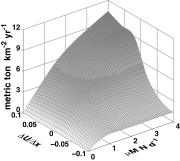Ocean fronts drive marine fishery production and biogeochemical cycling
- PMID: 25624488
- PMCID: PMC4330775
- DOI: 10.1073/pnas.1417143112
Ocean fronts drive marine fishery production and biogeochemical cycling
Abstract
Long-term changes in nutrient supply and primary production reportedly foreshadow substantial declines in global marine fishery production. These declines combined with current overfishing, habitat degradation, and pollution paint a grim picture for the future of marine fisheries and ecosystems. However, current models forecasting such declines do not account for the effects of ocean fronts as biogeochemical hotspots. Here we apply a fundamental technique from fluid dynamics to an ecosystem model to show how fronts increase total ecosystem biomass, explain fishery production, cause regime shifts, and contribute significantly to global biogeochemical budgets by channeling nutrients through alternate trophic pathways. We then illustrate how ocean fronts affect fishery abundance and yield, using long-term records of anchovy-sardine regimes and salmon abundances in the California Current. These results elucidate the fundamental importance of biophysical coupling as a driver of bottom-up vs. top-down regulation and high productivity in marine ecosystems.
Keywords: Reynolds decomposition; aggregation; fronts; trophic interactions.
Conflict of interest statement
The authors declare no conflict of interest.
Figures




Similar articles
-
Predicting Consumer Biomass, Size-Structure, Production, Catch Potential, Responses to Fishing and Associated Uncertainties in the World's Marine Ecosystems.PLoS One. 2015 Jul 30;10(7):e0133794. doi: 10.1371/journal.pone.0133794. eCollection 2015. PLoS One. 2015. PMID: 26226590 Free PMC article.
-
Long-term oceanographic and ecological research in the Western English Channel.Adv Mar Biol. 2005;47:1-105. doi: 10.1016/S0065-2881(04)47001-1. Adv Mar Biol. 2005. PMID: 15596166 Review.
-
Twenty-first-century climate change impacts on marine animal biomass and ecosystem structure across ocean basins.Glob Chang Biol. 2019 Feb;25(2):459-472. doi: 10.1111/gcb.14512. Epub 2018 Dec 1. Glob Chang Biol. 2019. PMID: 30408274
-
Persistence of trophic hotspots and relation to human impacts within an upwelling marine ecosystem.Ecol Appl. 2017 Mar;27(2):560-574. doi: 10.1002/eap.1466. Epub 2017 Feb 24. Ecol Appl. 2017. PMID: 27862556
-
Animal pee in the sea: consumer-mediated nutrient dynamics in the world's changing oceans.Glob Chang Biol. 2017 Jun;23(6):2166-2178. doi: 10.1111/gcb.13625. Epub 2017 Feb 20. Glob Chang Biol. 2017. PMID: 28217892 Review.
Cited by
-
Prey-size plastics are invading larval fish nurseries.Proc Natl Acad Sci U S A. 2019 Nov 26;116(48):24143-24149. doi: 10.1073/pnas.1907496116. Epub 2019 Nov 11. Proc Natl Acad Sci U S A. 2019. PMID: 31712423 Free PMC article.
-
Memory and resource tracking drive blue whale migrations.Proc Natl Acad Sci U S A. 2019 Mar 19;116(12):5582-5587. doi: 10.1073/pnas.1819031116. Epub 2019 Feb 25. Proc Natl Acad Sci U S A. 2019. PMID: 30804188 Free PMC article.
-
Influence of the El Niño-Southern Oscillation on SST Fronts Along the West Coasts of North and South America.J Geophys Res Oceans. 2022 Oct;127(10):e2022JC018479. doi: 10.1029/2022JC018479. Epub 2022 Oct 10. J Geophys Res Oceans. 2022. PMID: 36582262 Free PMC article.
-
Big or small, patchy all: Resolution of marine plankton patch structure at micro- to submesoscales for 36 taxa.Sci Adv. 2021 Nov 19;7(47):eabk2904. doi: 10.1126/sciadv.abk2904. Epub 2021 Nov 19. Sci Adv. 2021. PMID: 34797707 Free PMC article.
-
Information limitation and the dynamics of coupled ecological systems.Nat Ecol Evol. 2020 Jan;4(1):82-90. doi: 10.1038/s41559-019-1008-x. Epub 2019 Oct 28. Nat Ecol Evol. 2020. PMID: 31659309
References
-
- Chassot E, et al. Global marine primary production constrains fisheries catches. Ecol Lett. 2010;13(4):495–505. - PubMed
-
- Frank KT, Petrie B, Shackell NL. The ups and downs of trophic control in continental shelf ecosystems. Trends Ecol Evol. 2007;22(5):236–242. - PubMed
-
- Sabine CL, et al. The oceanic sink for anthropogenic CO2. Science. 2004;305(5682):367–371. - PubMed
-
- Hegerl GC, Bindoff NL. Ocean science. Warming the world’s oceans. Science. 2005;309(5732):254–255. - PubMed
-
- Barnett TP, et al. Penetration of human-induced warming into the world’s oceans. Science. 2005;309(5732):284–287. - PubMed
Publication types
MeSH terms
LinkOut - more resources
Full Text Sources
Other Literature Sources

